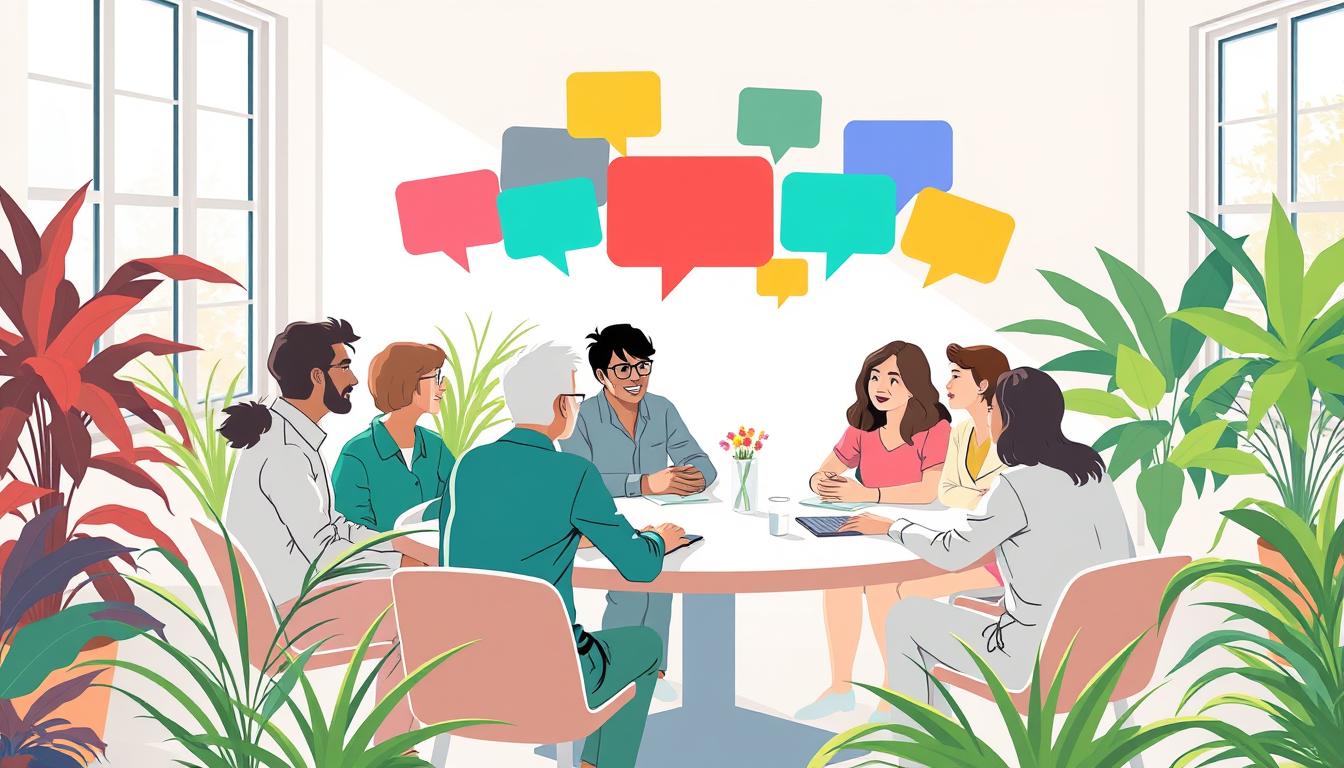A powerful connection can change the course of our lives. Unlocking effective communication opens doors to new opportunities, strengthens relationships, and fosters deep understanding. Having navigated communication challenges, I’ve seen the transformative power of this skill. This article will guide you through the art of effective communication. You’ll learn to express yourself clearly, connect deeply with others, and make your voice heard. This will positively impact your personal and professional life.
Key Takeaways
- Effective communication is a fundamental skill that can unlock new opportunities and deepen relationships.
- This article will provide strategies for expressing yourself with clarity, connecting with others, and making your voice heard.
- Mastering the art of effective communication can contribute to personal growth and professional success.
- The journey of effective communication begins with a focus on active listening, empathy, and understanding your audience.
- Developing emotional intelligence and the power of storytelling can further enhance your communication abilities.
Understanding the Importance of Effective Communication
Effective communication is the bedrock of meaningful relationships, both in our personal lives and professional endeavors. It goes beyond simple word exchange, fostering a deeper grasp of ideas, emotions, and viewpoints. By mastering the art of effective communication, individuals can unlock countless opportunities for success, personal growth, and fulfillment.
In our personal lives, effective communication strengthens bonds, resolves conflicts, and builds empathy. It allows us to share our thoughts and feelings clearly, leading to deeper connections with family, friends, and loved ones. It also plays a vital role in professional settings, driving successful negotiations, fostering collaborative work environments, and enhancing leadership abilities.
Effective communication is not merely a skill but a transformative force that can shape our experiences and propel us towards greater personal and professional achievements. By prioritizing clear, empathetic, and adaptable communication, individuals can unlock doors to new opportunities, deepen relationships, and navigate challenges with greater ease.
“Communication is the essence of human connection. It’s the way we share our thoughts, feelings, and experiences with others, and it’s the foundation of all our relationships.”
Whether you’re seeking to enhance your personal relationships or advance your professional career, the importance of effective communication cannot be overstated. By honing this essential skill, you can unlock a world of possibilities and pave the way for a more fulfilling and successful life.
The Fundamentals of Active Listening
Effective communication is the cornerstone of meaningful connections and successful collaborations. At the heart of this art lies the practice of active listening – a skill that transcends mere words. It opens the door to deeper understanding and empathy.
Giving Your Full Attention
Active listening involves more than just hearing the words spoken. It requires fully focusing on the speaker, suspending judgment, and actively engaging with the message. By tuning in with intention, you demonstrate respect. This creates an environment where the speaker feels heard and valued.
Showing Empathy and Understanding
The true power of active listening lies in its ability to foster empathy and cultivate a genuine connection. When you put yourself in the speaker’s shoes, reflect their emotions, and express understanding, you build trust. This empathetic approach is a cornerstone of effective communication. It lays the foundation for active listening skills that can transform your personal and professional relationships.
| Active Listening | Empathetic Listening |
|---|---|
| Focused attention on the speaker’s words and messages | Understanding the speaker’s emotions and perspective |
| Asking clarifying questions to ensure comprehension | Expressing empathy and validating the speaker’s feelings |
| Providing feedback to demonstrate understanding | Offering emotional support and a non-judgmental presence |
By mastering the fundamentals of active listening and empathetic listening, you can strengthen your communication foundations. This unlocks the true potential of your interactions. It fosters deeper connections and more meaningful exchanges.
“The most important thing in communication is to hear what isn’t being said.” – Peter Drucker
Mastering the Art of Effective Communication
Effective communication is key to success in both personal and professional life. By mastering effective communication, you can navigate complex interactions, build meaningful connections, and open doors to new opportunities. We will delve into the essential communication techniques and communication best practices to enhance your skills.
At the core of effective communication is understanding oneself and others. Developing self-awareness, empathy, and adapting your communication style are crucial. These principles help you become more persuasive, influential, and respected.
- Cultivate Active Listening: Focus fully on the speaker and show genuine interest. Practice by maintaining eye contact, asking questions, and summarizing key points.
- Prioritize Clarity and Conciseness: Communicate ideas clearly and concisely, avoiding jargon. Organize your thoughts and deliver your message briefly to ensure understanding.
- Modulate Your Tone and Volume: The way you convey your message impacts its effectiveness. Experiment with tone, pace, and volume to engage your audience.
- Leverage Nonverbal Communication: Your body language and facial expressions can enhance or detract from your message. Use them to add authenticity and confidence.
- Adapt to Your Audience: Tailor your communication to your audience’s preferences and styles. This ensures your message resonates effectively.
Mastering effective communication is a lifelong journey. By adopting these strategies, you’ll become more confident, persuasive, and impactful. This opens doors to personal and professional growth.
| Communication Technique | Description | Benefits |
|---|---|---|
| Active Listening | Giving your full attention to the speaker and demonstrating genuine interest in their message. | Fosters deeper understanding, builds trust, and shows respect for the speaker. |
| Clarity and Conciseness | Conveying ideas with precision and avoiding unnecessary jargon or ambiguity. | Ensures the audience understands and retains the information effectively. |
| Tone and Volume Modulation | Experimenting with variations in tone, pace, and volume to captivate the audience. | Enhances the emotional resonance and impact of the communication. |
| Nonverbal Communication | Leveraging body language, gestures, and facial expressions to reinforce the verbal message. | Enhances the authenticity and confidence in the communication. |
| Audience Adaptation | Tailoring the communication approach to the preferences, cultural backgrounds, and communication styles of the audience. | Ensures the message resonates more effectively with the target audience. |
By integrating these communication techniques and communication best practices into your daily interactions, you can unlock your full communication potential. This makes you a more influential and respected communicator.
“The true art of communication is the language of leadership.” – James Humes
Verbal Communication Techniques
To effectively convey your message, your verbal communication skills are paramount. Clarity and conciseness, along with mastering the appropriate tone and volume, are key. These aspects are crucial for successful verbal communication.
Clarity and Conciseness
When communicating verbally, clarity and conciseness are essential. Avoid jargon, complex language, and unnecessary details that could confuse your audience. Instead, aim for a simple, straightforward delivery that efficiently conveys your point.
By focusing on clarity in communication, you ensure your audience fully understands and retains the information. This approach makes your message more impactful and memorable.
Tone and Volume Modulation
The delivery of your message is just as important as its content. Your tone and volume in communication significantly influence how your audience perceives and responds. Speak with confidence and clarity, adjusting your volume and tone to fit the situation and audience.
A well-modulated verbal communication skills can engage your listeners and effectively convey your message. This skill is vital for successful communication.
| Technique | Description | Example |
|---|---|---|
| Clarity and Conciseness | Deliver your message in a simple, straightforward manner, avoiding jargon and unnecessary details. | “The new project timeline is three months, with the first phase completed by the end of next week.” |
| Tone and Volume Modulation | Adapt your tone and volume to the situation and audience, speaking with confidence and clarity. | “I’m excited to share the details of our marketing strategy for the upcoming campaign.” |
“The art of communication is the language of leadership.” – James Humes
By mastering verbal communication skills, you can effectively convey your message. This enhances your ability to engage your audience and boosts the effectiveness of your communication efforts.
Nonverbal Communication Mastery
Effective communication transcends spoken words. Nonverbal cues like body language and significantly influence how our messages are received. By grasping and mastering nonverbal communication, we can refine our communication skills. This enables us to connect more deeply with our audience.
Body Language and Gestures
Your body language reveals much about your inner state. Good posture, eye contact, and facial expressions can make you appear confident and welcoming. Gestures can also highlight your points, express feelings, and clarify your message. Yet, it’s crucial to use them wisely, as overuse or misuse can divert attention or send mixed signals.
- Maintain an open and upright posture to project confidence and approachability.
- Make eye contact to establish a connection and demonstrate engagement.
- Use hand gestures to emphasize key points and add visual interest to your message.
- Avoid crossed arms or fidgeting, as these can be perceived as closed off or nervous.
| Nonverbal Cue | Positive Interpretation | Negative Interpretation |
|---|---|---|
| Eye Contact | Engaged, attentive, trustworthy | Dishonest, uncomfortable, disinterested |
| Posture | Confident, open, relaxed | Closed off, defensive, insecure |
| Gestures | Expressive, enthusiastic, clarifying | Distracting, nervous, aggressive |
By paying attention to your nonverbal signals, you can boost your effectiveness. This approach ensures a lasting, positive impact on your audience.
“The most important thing in communication is to hear what isn’t being said.” – Peter Drucker
Adapting Your Communication Style
Effective communication is not a one-size-fits-all approach. To truly connect with your audience, it’s crucial to adapt your communication style based on their needs, preferences, and cultural background. By understanding your audience, you can tailor your message and delivery to ensure your words resonate and create a meaningful impact.
Understanding Your Audience
Before you can effectively adapt your communication style, you need to understand your audience. This involves researching their demographics, interests, communication preferences, and potential pain points. By gaining this insight, you can adjust your language, tone, and approach to better suit their needs.
- Identify the age, gender, and education level of your audience
- Understand their interests, challenges, and communication preferences
- Determine the most effective channels to reach and engage them
Cultural Sensitivity and Awareness
In today’s increasingly diverse world, cultural sensitivity and awareness are essential for effective communication. By respecting and understanding different cultural norms, values, and communication styles, you can navigate interactions with tact and build stronger connections with your audience.
- Research and familiarize yourself with the cultural backgrounds of your audience
- Avoid making assumptions or using language that could be perceived as insensitive or offensive
- Demonstrate a willingness to learn and adapt your communication style accordingly
Adapting your communication style is not just about the words you use; it’s about truly understanding and connecting with your audience. By taking the time to learn about their needs and cultural considerations, you can create a more inclusive and impactful communication experience.

Enhancing Your Written Communication
Effective written communication is key to professional success. Whether you’re writing a report, an email, or a proposal, the structure and flow of your content are crucial. They determine how well your message is received and understood.
Structure, Organization, and Flow
Organizing your written communication well helps your audience follow your content easily. Use clear headings, concise paragraphs, and strategic bullet points. These elements break up text and guide your reader through your message. Proper grammar and spelling are also essential for a polished and professional look.
To improve your written communication’s structure and flow:
- Use clear and informative headings to introduce key sections or ideas
- Organize your content into well-structured paragraphs, each focusing on a single point or concept
- Leverage bulleted or numbered lists to present information in a clear and easy-to-digest format
- Ensure logical transitions between paragraphs and sections to maintain a cohesive narrative
- Review and proofread your work to identify and correct any grammatical or spelling errors
By mastering the basics of written communication skills, you can enhance your effective writing and structuring written communication in your professional life. This will leave a lasting impression on your audience.
“Good writing is not a natural gift. You have to learn to write well. It’s no different than learning to play the piano.” – T.E. Coraghessan Boyle
| Effective Writing Strategies | Key Benefits |
|---|---|
| Clear and concise language | Improved understanding and engagement |
| Logical organization and flow | Enhanced readability and comprehension |
| Attention to grammar and spelling | Increased professionalism and credibility |
Developing Emotional Intelligence
Emotional intelligence is crucial for effective communication. It allows you to recognize, understand, and manage your emotions and those of others. Developing self-awareness and emotional management skills helps you navigate tough interactions with empathy.
Self-Awareness and Emotional Management
Knowing your emotions and their impact on communication is vital. Identifying your emotional states and their effects gives you control over your responses. This self-awareness lets you choose how to express yourself, ensuring your message is clear.
Social Awareness and Empathy
Social awareness is key to effective communication. It involves recognizing and understanding the emotions and needs of those around you. Developing empathy allows you to adjust your communication to meet your audience’s needs. This approach fosters deeper connections and improves interaction quality.
| Emotional Intelligence Competencies | Description |
|---|---|
| Self-Awareness | The ability to recognize your own emotions and understand how they influence your behavior and decision-making. |
| Emotional Management | The capacity to regulate and control your emotions, enabling you to respond to situations in a constructive manner. |
| Social Awareness | The awareness of others’ emotions, needs, and concerns, allowing you to empathize and adapt your communication accordingly. |
| Empathy | The ability to understand and share the feelings of others, fostering more meaningful and effective communication. |

By developing emotional intelligence, you unlock your communication skills’ full potential. This leads to deeper connections, better conflict resolution, and achieving personal and professional goals.
The Power of Storytelling in Communication
When sharing complex information, like in a presentation, the key to grabbing your audience’s attention is storytelling. Instead of just listing facts and figures, creating a narrative that connects with your listeners makes your message stick. It becomes more engaging and memorable.
At the core of narrative communication is simplifying your main message into a single, impactful theme. Then, you can craft a story around it. This story can link to real-life events or personal stories, showing its significance and relevance.
Using the emotional strength of storytelling in communication helps you connect with your audience on a deeper level. When information is told as a story, it becomes more relatable and understandable. People naturally respond to the human touch in a well-told story.
“The greatest communication tool you have is your own personal story, which you should share and be the brand of.”
– Jay Baer, marketing consultant and author
Mastering engaging communication through storytelling requires effort, but the benefits are immense. By turning your message into a compelling story, you can captivate your audience. You leave a lasting impression and effectively convey your key points in a memorable way.
Effective Communication in Conflict Resolution
Effective communication in conflict resolution is key to finding solutions that benefit everyone. By addressing concerns calmly and constructively, you can resolve conflicts in a way that satisfies all parties. This approach ensures that everyone’s needs are considered.
At the core of effective communication for problem-solving lies the ability to actively listen. This means truly grasping the other party’s perspective, acknowledging their concerns, and finding common ground. It’s about setting aside personal biases to engage in a genuine dialogue.
- Actively listen to the other party’s concerns and perspectives.
- Acknowledge their emotions and feelings to demonstrate empathy.
- Identify shared goals and areas of agreement to establish a foundation for resolution.
- Propose solutions that address the needs and interests of all involved.
- Ensure clear, concise communication throughout the process.
Mastering the art of communication in conflict resolution can turn tense situations into productive discussions. This approach not only leads to better outcomes but also strengthens relationships over time.
“The most important thing in communication is to hear what isn’t being said.” – Peter Drucker

Ultimately, resolving conflicts through effective communication requires patience, empathy, and a genuine desire to find a solution that works for everyone. By approaching conflicts with an open mind and a commitment to understanding, you can unlock the power of communication. This transforms challenges into opportunities for growth and progress.
Building Rapport and Trust Through Communication
Effective communication is the foundation of building strong relationships and trust. It’s crucial when interacting with colleagues, clients, or loved ones. The ability to communicate authentically can greatly impact the quality of your connections.
At the core of building rapport and trust is active listening. Giving your full attention shows genuine interest in the other person’s thoughts and feelings. This not only helps you understand their needs but also shows you value their input, essential for trust.
Adapting your communication style to your audience’s preferences is vital. Being aware of cultural differences and individual communication styles ensures your message is received effectively. This tailored approach strengthens your relationships.
Building rapport and trust through communication means creating a safe, inclusive environment. Prioritizing empathy, adaptability, and genuine engagement builds the foundation for meaningful relationships. These relationships can thrive both personally and professionally.
| Strategies for Building Rapport and Trust | Benefits of Effective Communication |
|---|---|
|
|
Mastering effective communication unlocks the power to build lasting rapport and trust. Remember, communication is a skill that can be developed and refined. Embrace the journey of continuous improvement and feedback to become a more effective communicator.
“The most important thing in communication is to hear what isn’t being said.” – Peter Drucker
Continuous Improvement and Feedback
Mastering effective communication is a lifelong journey that demands ongoing self-assessment and improvement. Seeking communication feedback from others, whether positive or constructive, is crucial. It helps pinpoint areas for growth and aids in developing strategies to boost your communication skills. Reflecting on your communication practices regularly and making necessary adjustments can significantly enhance your effectiveness over time.
Embracing communication self-assessment is a key to enhancing your skills. This involves regularly evaluating your communication strengths and weaknesses. Then, you can implement targeted strategies to improve areas that need work. This might include practicing active listening, refining non-verbal cues, or enhancing your written communication style.
Feedback from colleagues, friends, or communication experts is invaluable. By asking for honest feedback, you gain insights into how others perceive your communication style. This feedback is a gift, offering the information needed to continually refine and improve your communication skills.
| Effective Communication Feedback Strategies | Benefits |
|---|---|
|
|
“The art of communication is the language of leadership.” – James Humes
The path to becoming an exceptional communicator is ongoing. By embracing communication feedback and self-assessment, you can continually refine your skills. This will make you a more effective, influential, and impactful communicator.
Conclusion
Effective communication is crucial for both personal and professional success. By applying the strategies and techniques discussed, you can enhance your communication skills. This will open up new opportunities and strengthen your relationships. Remember, improving your communication is a continuous journey. The rewards it brings are well worth the effort.
As you work on improving your communication, keep a growth mindset. View every interaction as a chance to learn and grow. Seek feedback, reflect on your experiences, and adjust your approach as needed. This will make you a confident and compelling communicator, ready to handle various situations with ease.
The key takeaways from this article highlight the importance of active listening and using both verbal and nonverbal cues. Adapting your style to your audience and cultivating emotional intelligence are also crucial. By mastering these principles, you’ll become a master of effective communication. This will unlock your full potential and help you build lasting connections in your life.
FAQ
What is the importance of effective communication?
Effective communication is vital for building strong relationships and achieving success. It transforms personal and professional interactions, opening up new opportunities and fostering personal growth.
What is the foundation of effective communication?
Active listening forms the core of effective communication. It requires focusing fully on the speaker and providing feedback to ensure understanding. Empathetic listening goes further, recognizing emotions and expressing empathy.
How can you communicate effectively through verbal communication?
For clear verbal communication, keep your message simple and direct. Avoid jargon and unnecessary details. Your tone and volume are also crucial, as they affect how your message is received.
How can you communicate effectively through nonverbal communication?
Your body language and gestures convey much about your emotions. Good posture, eye contact, and facial expressions show confidence and approachability. Use gestures wisely to emphasize points and express emotions.
How can you adapt your communication style to different audiences?
Adapting to your audience’s needs and background is key. Consider their preferences and cultural differences. This ensures your message resonates effectively.
How can you enhance your written communication?
Organize your written content to enhance clarity. Use headings, bullet points, and paragraphs to guide readers. Accurate grammar and spelling are essential for professionalism.
How can emotional intelligence improve your communication?
Emotional intelligence helps you manage your and others’ emotions. Self-awareness and social awareness are crucial. They enable you to adjust your communication style to meet others’ needs.
How can storytelling enhance your communication?
Storytelling makes complex information engaging. Distill your message to one core idea and craft a narrative. Linking to real-world events or anecdotes makes your message memorable.
How can effective communication help resolve conflicts?
Effective communication is vital in conflict resolution. Address concerns calmly and constructively. Active listening and finding common ground lead to mutually beneficial solutions.
How can effective communication help build rapport and trust?
Effective communication builds rapport and trust. Active listening, empathy, and adapting to your audience’s needs foster stronger connections. This is crucial in personal and professional relationships.
How can you continuously improve your communication skills?
Improving communication skills is an ongoing process. Seek feedback and reflect on your practices regularly. This helps you grow and become a more effective communicator.
